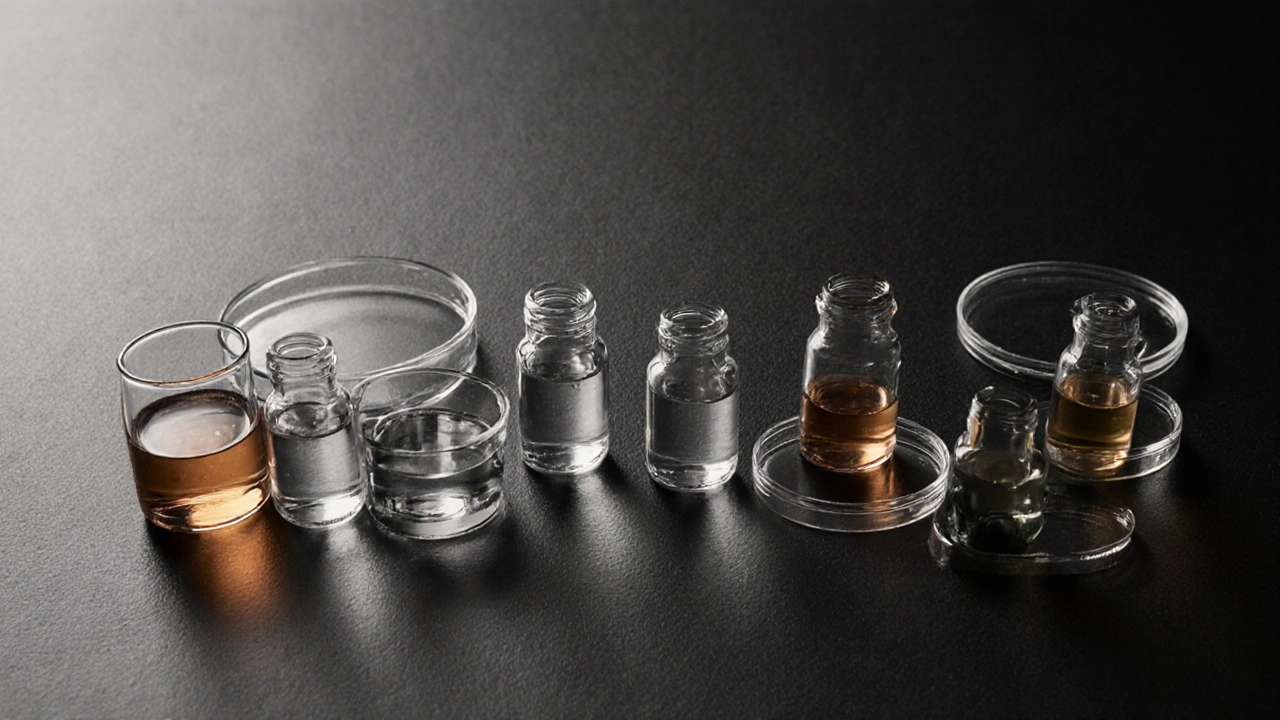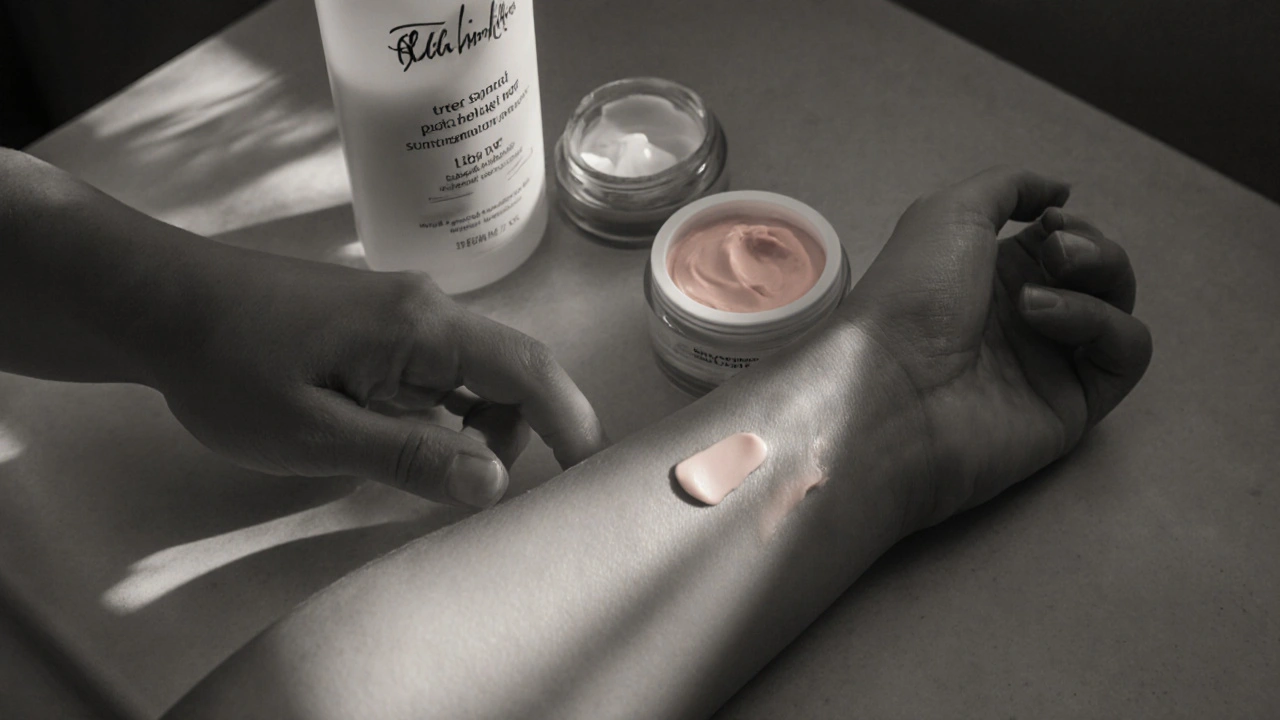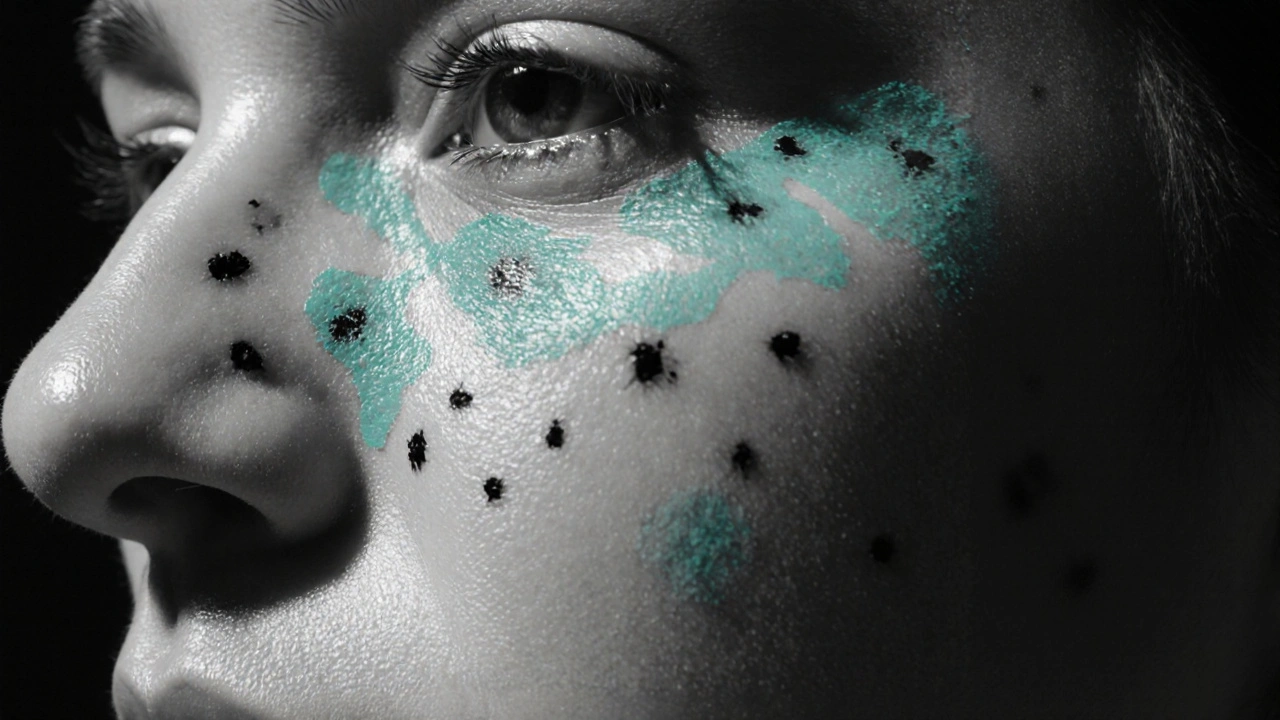Skin Lightening Agent Selector
Choose Your Skin Concerns
How Sensitive Is Your Skin?
What's Most Important to You?
Your Recommended Options
Fading dark spots, melasma, or post‑inflammatory hyperpigmentation can feel like a never‑ending battle. Everyone wants a clear, even tone, but the market is flooded with ingredients that promise results. This article breaks down the science, safety, and real‑world performance of hydroquinone and its most common rivals, so you can decide which ingredient fits your skin and lifestyle.
What is Hydroquinone?
Hydroquinone is a synthetic phenolic compound that inhibits the enzyme tyrosinase, the key driver of melanin production. By slowing melanin synthesis, it lightens existing pigment and prevents new spots from forming. First approved in the 1960s, hydroquinone remains the gold standard for treating stubborn hyperpigmentation, especially melasma. Typical prescription strengths range from 2% (over‑the‑counter in some regions) to 4% or higher under dermatologist supervision. The effect usually appears within 2-4 weeks, with maximal improvement by 8-12 weeks.
Other Popular Skin Lightening Agents
Below is a quick snapshot of the most widely used alternatives. Each works through a slightly different pathway, which influences efficacy, irritation risk, and suitability for different skin types.
- Kojic Acid is a fungal‑derived metabolite that also blocks tyrosinase. It’s commonly found in serums at 1-4% concentrations.
- Azelaic Acid is a dicarboxylic acid with both depigmenting and anti‑inflammatory properties, often used at 10-20% for rosacea and melasma.
- Vitamin C (Ascorbic Acid) works as an antioxidant and reduces melanin formation by scavenging free radicals that trigger tyrosinase.
- Arbutin is a plant‑derived glycoside that slowly releases hydroquinone‑like molecules, offering milder action.
- Niacinamide (Vitamin B3) interferes with melanosome transfer from melanocytes to skin cells, giving a subtle brightening effect.
- Retinoic Acid (Tretinoin) accelerates skin turnover, helping shed pigmented cells faster while also boosting collagen.
- Tranexamic Acid blocks the interaction between melanocytes and fibroblasts, useful especially for melasma on the cheeks.
- Licorice Extract contains glabridin, an inhibitor of tyrosinase that also soothes inflammation.
- Glutathione is a powerful antioxidant that reduces melanin synthesis by shifting the oxidation state of melanocytes.

How Do We Compare These Ingredients?
When choosing a brightening agent, most people weigh four main factors:
- Efficacy - How quickly and how much pigment does the ingredient fade?
- Safety & Tolerability - Risk of irritation, allergic reactions, or long‑term side effects.
- Regulatory Status & Availability - Is it OTC, prescription‑only, or restricted in certain countries?
- Cost & Convenience - Price per month, ease of incorporation into a routine, and need for professional supervision.
Below is a side‑by‑side look that scores each ingredient on a 1‑5 scale (5 = best) based on clinical data up to 2025.
| Ingredient | Efficacy | Safety | Regulation | Cost (USD / month) |
|---|---|---|---|---|
| Hydroquinone | 5 | 3 | Prescription in EU/UK, OTC 2% in US | 30-50 |
| Kojic Acid | 3 | 4 | OTC worldwide | 15-25 |
| Azelaic Acid | 4 | 4 | OTC 10% in EU, prescription 15-20% US | 35-60 |
| Vitamin C | 2 | 5 | OTC | 20-40 |
| Arbutin | 3 | 5 | OTC | 25-45 |
| Niacinamide | 2 | 5 | OTC | 10-20 |
| Retinoic Acid | 4 | 3 | Prescription | 40-70 |
| Tranexamic Acid | 4 | 4 | Prescription (oral) or OTC (topical) in some regions | 30-55 |
| Licorice Extract | 2 | 5 | OTC | 15-30 |
| Glutathione | 3 | 4 | OTC (topical) / injectable (limited markets) | 40-80 |
When Hydroquinone Is the Right Choice
If you have deep‑set melasma, stubborn post‑inflammatory spots, or a history of poor response to milder agents, hydroquinone often delivers the fastest and most complete fade. It works best when paired with sunscreen (minimum SPF 30) and a gentle cleanser to avoid irritation. Because the molecule can cause ochronosis (a permanent darkening) with long‑term misuse, most dermatologists recommend a 12‑week cycle followed by a break.
Best Alternatives for Sensitive or Pregnant Skin
For those who experience redness, stinging, or who are avoiding prescription drugs, the safer picks are:
- Kojic Acid - good for mild discoloration; watch for contact dermatitis in very sensitive skin.
- Azelaic Acid - excellent for acne‑prone individuals who also need brightening.
- Vitamin C + Niacinamide - a combo that brightens gradually while strengthening the barrier.
- Arbutin - offers a hydroquinone‑like effect at a fraction of the irritation risk.
Pregnant or nursing patients should stick to antioxidant‑based agents (Vitamin C, Licorice Extract) because they have the safest profiles.

Safety Tips & Common Pitfalls
Regardless of the ingredient, a few rules keep your skin happy:
- Always apply sunscreen 15 minutes before heading outdoors; UV exposure can reverse any brightening gains.
- Introduce one new product at a time. Mixing multiple strong actives (e.g., hydroquinone plus retinoic acid) can trigger severe irritation.
- Watch for the “triple‑A” sign - redness, burning, and flaking. If it appears, cut back frequency or switch to a milder agent.
- Do a48‑hour patch test before committing to a new formula, especially with acids or phenols.
How to Build a Personalized Brightening Routine
- Assess Your Pigment Type - facial melasma, post‑acne marks, or sun‑spots each respond differently.
- Pick a Primary Agent - use the comparison table to match efficacy with your tolerance level.
- Layer Strategically - start with a gentle cleanser, follow with the brightening agent (allow 5‑10min for absorption), then seal with a moisturizer containing niacinamide or ceramides.
- Sun Protection is Non‑Negotiable - a broad‑spectrum SPF 30+ applied every 2hours outdoors.
- Monitor Progress - take weekly photos under consistent lighting. If no improvement after 8 weeks, consider stepping up to a stronger ingredient or consulting a dermatologist.
Frequently Asked Questions
Can I use hydroquinone over the counter?
In the United States, a 2% hydroquinone cream is available OTC, but higher concentrations (4%+) require a prescription. In the UK and most of Europe, any concentration above 2% is prescription‑only.
How long does it take to see results?
Most users notice a visible lightening after 2-4weeks, with peak results around 8-12weeks. Faster outcomes are often seen with prescription‑strength hydroquinone combined with a retinoid.
Is hydroquinone safe for long‑term use?
Long‑term continuous use is not recommended because of rare but serious side effects like exogenous ochronosis. Dermatologists typically advise a 12‑week treatment followed by a break, then re‑evaluation.
Which alternative is best for sensitive skin?
Arbutin, vitaminC, and niacinamide are the most gentle options. They provide modest brightening without the burning that hydroquinone or strong acids can cause.
Do I need a dermatologist to use hydroquinone?
While OTC 2% creams are legal, a dermatologist can tailor concentration, monitor for side effects, and combine it with other actives for faster results. For severe melasma, professional guidance is strongly advised.
Choosing the right brightening agent boils down to balancing how quickly you need results with how much irritation you can tolerate. Hydroquinone still leads on raw efficacy, but safer, gentler alternatives exist for everyday use. Remember: consistency, sun protection, and realistic expectations are the real game‑changers for a clearer complexion.

13 Responses
Hydroquinone works fast but it burns like hell
The efficacy of hydroquinone undeniably positions it at the apex of depigmentation agents; however, its safety profile warrants meticulous supervision.
Dermatologists typically prescribe a 12‑week regimen followed by a hiatus to avert ochronosis.
Patients with sensitive dermis may experience erythema, necessitating the adjunctive use of soothing emollients.
Consequently, a balanced approach that couples hydroquinone with vigilant photoprotection represents best practice.
When you scan the table of alternatives you quickly notice that each component follows its own pathway to lighten skin.
Kojic acid chews at tyrosinase just enough to dim mild discoloration but many users report a lingering itch after application.
Azelaic acid doubles as an anti‑inflammatory which makes it a solid choice for those battling both acne and pigment.
Vitamin C acts more like a shield against free radicals while it slowly nudges melanin production downward.
Arbutin releases a hydroquinone‑like molecule in a controlled fashion and therefore tends to be kinder on delicate epidermis.
Niacinamide, although modest in visual impact, fortifies the skin barrier and can calm the redness that stronger acids provoke.
Retinoic acid speeds up cell turnover and can amplify the results of any brightening regimen if used correctly.
Finally, consistent use of broad‑spectrum sunscreen is the single most important factor regardless of the active ingredient employed.
If you think burning is a badge of honor you’re missing the point; real results come from disciplined use, not reckless fire.
True mastery respects the skin’s limits while coaxing it toward clarity.
Let’s think of a brightening routine as a step‑by‑step mentorship program for your epidermis.
First, cleanse with a pH‑balanced formula that leaves the barrier intact.
Second, apply the chosen active ingredient, allowing a few minutes for it to settle before any additional layers.
Third, seal the effort with a moisturizer rich in ceramides or niacinamide to reinforce resilience.
Finally, never skip the sunscreen; it is the guardian that protects all the hard work you’ve invested.
By following this structured approach, even the most stubborn hyperpigmentation can gradually fade without compromising skin health.
The journey toward an even complexion often begins with a deep understanding of what each ingredient actually does to the skin.
Hydroquinone, for instance, directly interrupts melanin synthesis, which explains its reputation as a powerhouse.
Yet power without balance can lead to irritation, so pairing it with barrier‑supporting actives becomes essential.
A gentle cleanser that respects the skin’s acid mantle should be the first step each morning and night.
Follow that with a thin layer of the chosen brightening agent, allowing five to ten minutes for absorption.
If hydroquinone is your main player, consider intermittently adding a retinoid at night to accelerate turnover, but never stack them on the same application.
For those who find hydroquinone too harsh, arbutin offers a slower release of a similar molecule, often tolerated by sensitive skins.
Niacinamide, while modest in brightening, fortifies the barrier and can mitigate the redness that acids sometimes provoke.
Vitamin C, as an antioxidant, not only curbs melanin formation but also protects against future UV‑induced damage.
Licorice extract adds an anti‑inflammatory touch, soothing any lingering irritation while still dimming dark spots.
Sun protection, however, remains the non‑negotiable pillar; a broad‑spectrum SPF 30+ applied every two hours outdoors safeguards every effort you’ve made.
Consistency is the silent hero-most clinicians recommend a minimum of eight weeks before judging efficacy.
Photograph your skin under consistent lighting every week; visual data beats vague memory.
When progress plateaus after twelve weeks, a short break from the active ingredient followed by a maintenance phase often restores responsiveness.
Ultimately, a personalized routine respects both the science and your unique skin narrative, turning the quest for radiance into a sustainable habit.
Honestly, the drama that surrounds skin‑lightening products feels like a soap opera; I’m here for the plot twists but I demand a happy ending for my complexion.
Reading the comprehensive breakdown reminds us that knowledge is the best foundation; embrace the science and let your skin thank you for the thoughtful care.
Love the table 😍
The truth about brightening lies not in a single miracle ingredient but in the disciplined harmony of many; treating the skin like a battlefield only yields casualties.
From a collaborative standpoint, pairing a low‑dose hydroquinone with a niacinamide‑rich moisturizer can create a synergistic effect that maximizes results while minimizing irritation.
Stay motivated! Every consistent application brings you one step closer to the clear, radiant skin you deserve-keep that routine alive and the results will follow.
It’s fascinating how cultural perceptions of skin tone shape product trends worldwide.